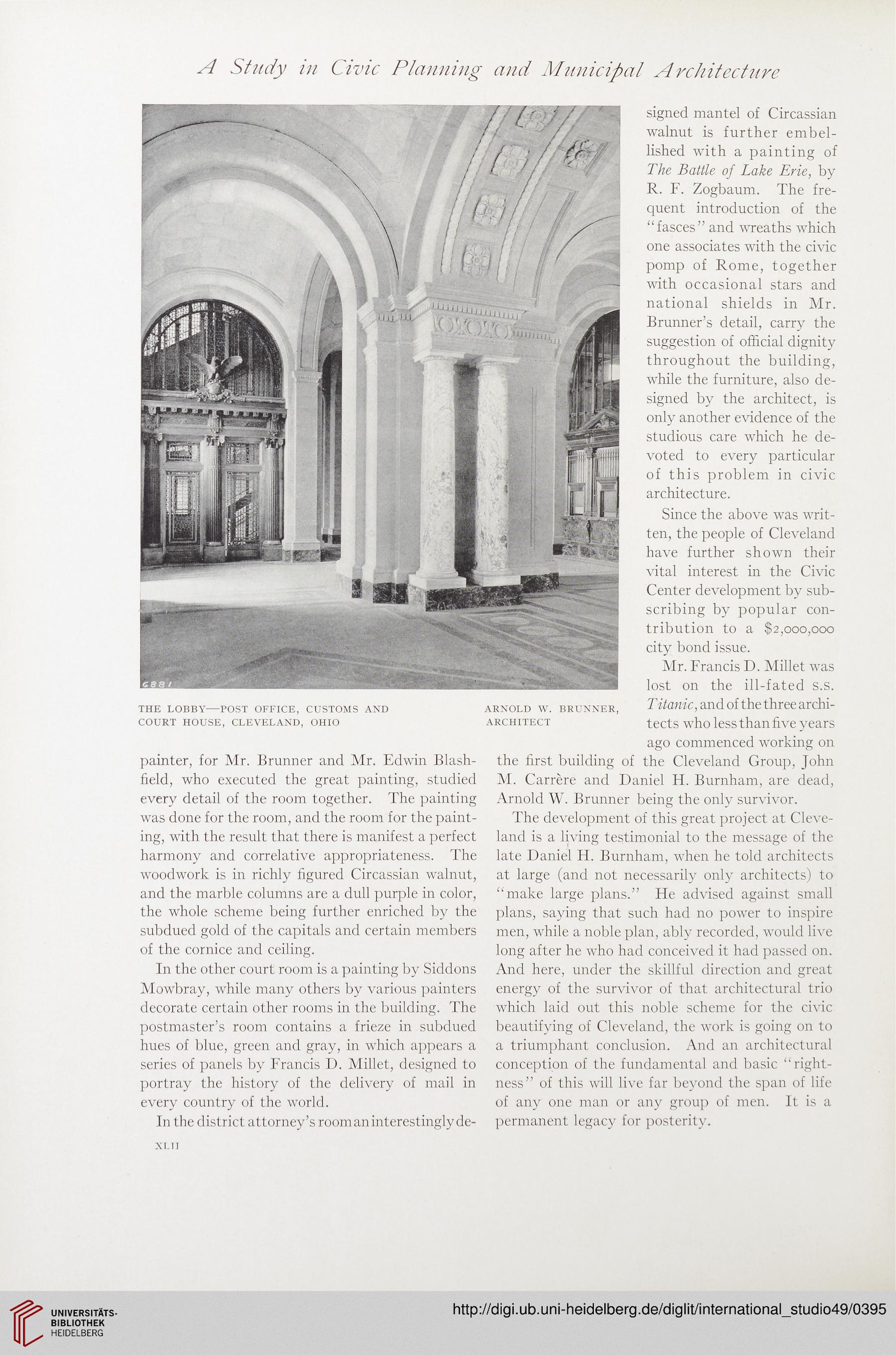A Study in Civic Planning and Municipal Architecture
THE LOBBY—POST OFFICE, CUSTOMS AND
COURT HOUSE, CLEVELAND, OHIO
painter, for Mr. Brunner and Mr. Edwin Blash-
field, who executed the great painting, studied
every detail of the room together. The painting
was done for the room, and the room for the paint-
ing, with the result that there is manifest a perfect
harmony and correlative appropriateness. The
woodwork is in richly figured Circassian walnut,
and the marble columns are a dull purple in color,
the whole scheme being further enriched by the
subdued gold of the capitals and certain members
of the cornice and ceiling.
In the other court room is a painting by Siddons
Mowbray, while many others by various painters
decorate certain other rooms in the building. The
postmaster’s room contains a frieze in subdued
hues of blue, green and gray, in which appears a
series of panels by Francis D. Millet, designed to
portray the history of the delivery of mail in
every country of the world.
In the district attorney’s room an interestingly de-
signed mantel of Circassian
walnut is further embel-
lished with a painting of
The Battle of Lake Erie, by
R. F. Zogbaum. The fre-
quent introduction of the
“fasces” and wreaths which
one associates with the civic
pomp of Rome, together
with occasional stars and
national shields in Mr.
Brunner’s detail, carry the
suggestion of official dignity
throughout the building,
while the furniture, also de-
signed by the architect, is
only another evidence of the
studious care which he de-
voted to every particular
of this problem in civic
architecture.
Since the above was writ-
ten, the people of Cleveland
have further shown their
vital interest in the Civic
Center development by sub-
scribing by popular con-
tribution to a $2,000,000
city bond issue.
Mr. Francis D. Millet was
lost on the ill-fated S.S.
Titanic, and of the three archi-
tects who less than five years
ago commenced working on
the first building of the Cleveland Group, John
M. Carrere and Daniel H. Burnham, are dead,
Arnold W. Brunner being the only survivor.
The development of this great project at Cleve-
land is a living testimonial to the message of the
late Daniel H. Burnham, when he told architects
at large (and not necessarily only architects) to
“make large plans.” He advised against small
plans, saying that such had no power to inspire
men, while a noble plan, ably recorded, would live
long after he who had conceived it had passed on.
And here, under the skillful direction and great
energy of the survivor of that architectural trio
which laid out this noble scheme for the civic
beautifying of Cleveland, the work is going on to
a triumphant conclusion. And an architectural
conception of the fundamental and basic “right-
ness” of this will live far beyond the span of life
of any one man or any group of men. It is a
permanent legacy for posterity.
ARNOLD w. BRUNNER,
ARCHITECT
XLII
THE LOBBY—POST OFFICE, CUSTOMS AND
COURT HOUSE, CLEVELAND, OHIO
painter, for Mr. Brunner and Mr. Edwin Blash-
field, who executed the great painting, studied
every detail of the room together. The painting
was done for the room, and the room for the paint-
ing, with the result that there is manifest a perfect
harmony and correlative appropriateness. The
woodwork is in richly figured Circassian walnut,
and the marble columns are a dull purple in color,
the whole scheme being further enriched by the
subdued gold of the capitals and certain members
of the cornice and ceiling.
In the other court room is a painting by Siddons
Mowbray, while many others by various painters
decorate certain other rooms in the building. The
postmaster’s room contains a frieze in subdued
hues of blue, green and gray, in which appears a
series of panels by Francis D. Millet, designed to
portray the history of the delivery of mail in
every country of the world.
In the district attorney’s room an interestingly de-
signed mantel of Circassian
walnut is further embel-
lished with a painting of
The Battle of Lake Erie, by
R. F. Zogbaum. The fre-
quent introduction of the
“fasces” and wreaths which
one associates with the civic
pomp of Rome, together
with occasional stars and
national shields in Mr.
Brunner’s detail, carry the
suggestion of official dignity
throughout the building,
while the furniture, also de-
signed by the architect, is
only another evidence of the
studious care which he de-
voted to every particular
of this problem in civic
architecture.
Since the above was writ-
ten, the people of Cleveland
have further shown their
vital interest in the Civic
Center development by sub-
scribing by popular con-
tribution to a $2,000,000
city bond issue.
Mr. Francis D. Millet was
lost on the ill-fated S.S.
Titanic, and of the three archi-
tects who less than five years
ago commenced working on
the first building of the Cleveland Group, John
M. Carrere and Daniel H. Burnham, are dead,
Arnold W. Brunner being the only survivor.
The development of this great project at Cleve-
land is a living testimonial to the message of the
late Daniel H. Burnham, when he told architects
at large (and not necessarily only architects) to
“make large plans.” He advised against small
plans, saying that such had no power to inspire
men, while a noble plan, ably recorded, would live
long after he who had conceived it had passed on.
And here, under the skillful direction and great
energy of the survivor of that architectural trio
which laid out this noble scheme for the civic
beautifying of Cleveland, the work is going on to
a triumphant conclusion. And an architectural
conception of the fundamental and basic “right-
ness” of this will live far beyond the span of life
of any one man or any group of men. It is a
permanent legacy for posterity.
ARNOLD w. BRUNNER,
ARCHITECT
XLII




